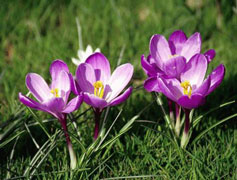


Home
Flowers &
Indoor Plants
Fruits & Nuts
Ornamentals
Vegetables
Special Topics
Resources
Glossary

|
Crocus Crocus sp. (crow-cus) |
 |
What about it? Crocuses are members of the his family. The resemblance can be found in the narrow, grass-like leaves of these plants. The leaves of the crocus are about 5 inches long. They grow directly out of the corm, or bulb. The flowers are funnel-shaped. They are one of the first signs of spring, blooming in late March or early April. There are several varieties in shades of gold, white, or purple. There are also fall-flowering varieties. What is it used for? They make a great border plant, as well as an addition to a rock garden. Most folks like to plant them in front of shrubbery; this gives the much-anticipated flowers a great green background. Crocuses make fantastic group plantings, where they freely naturalize and spread. They do not do well indoors or in window boxes because they need d i rect and constant sunlight. Where does it grow? How do we grow it?A spot with southern exposure is the best spot to plant crocuses. The warmth and sunlight will encourage them to open early. They prefer a well-drained soil. They are very hardy and do not need protection from the elements. What are its primary problems? Crocuses are rarely affected by any pests or diseases. You might find your flowers speckled with dark spots which indicates a virus disease known as 'breaking". Tulips get this too. The best thing to do is to remove and destroy the affected plant so that the others are not infected as well. How do we propagate it? Crocuses come from corms, or bulbs. Spring-blooming plants should be planted in September. Autumn-flowering crocuses can be set in the soil in late July. Bury the corms 2 or 3 inches deep.
© Copyright, Department of Horticulture, Cornell University. |